Thu 10 Jul 2008
Movie Review – LIGHTNING STRIKES TWICE (1951).
Posted by Steve under Mystery movies , Reviews[17] Comments
LIGHTNING STRIKES TWICE. Warner Brothers, 1951. Ruth Roman, Richard Todd, Mercedes McCambridge, Zachary Scott, Daryl Hickman. Based on the novel A Man Without Friends, by Margaret Echard (Doubleday, 1940). Directed by King Vidor.
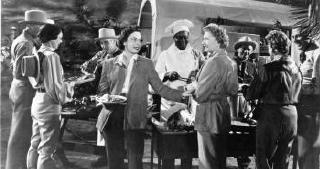
Except for a short but crucial opening sequence, this little known black-and-white film begins (as many other noir-type movies have, as I’ve pointed out before) with someone getting off a bus in a small town in the West or South, only to find themselves in middle of a case of murder, or a situation where passions are so inflamed that a murder is about to happen.
Except that the person getting off the bus is not Alan Ladd or Glenn Ford or Dana Andrews, it’s Ruth Roman. The town is apparently somewhere in the west Texas desert country, and but Shelley Carnes is definitely a loner of sorts, an actress who’s temporarily left her troupe and who’s planning to stay at a dude ranch in the area, needing a short respite from too much traveling on the road.
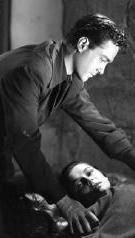
The opening few scenes, which I mentioned as being crucial, are exactly that. A young man named Richard Trevelyan (Richard Todd) has been convicted of killing his tramp of a wife, only to be given a stay of execution at the last minute and granted a new trial. The new trial has ended in a hung jury, with one woman managing to persuade five others that he is not guilty.
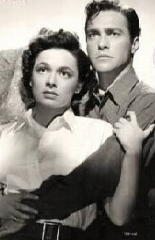
Enter Shelley Carnes. Trevelyan has returned but has gone into hiding. Shelley does not know it, but the dude ranch she is given directions to (with ulterior motives) has closed for the year. Liza McStringer (Mercedes McCambride) and her invalid brother own and operate the ranch, but they agree to let her stay.
It turns out that Liza was the holdout witness, and the local folks are pretty divided about it, since Trevelyan certainly looks guilty, nor has he said anything to anyone about the killing. So, given all this, who do you suppose Shelley meets accidentally, and who do you suppose she …
I hope you’re with me, because if I continue, I would be telling you the whole story, and that’s not what I intend to do. But as sure as Shelley is about Richard, it is obvious that some doubts still remain.
As for the players, Todd, an English actor, is miscast as a man of the desert, no matter how much is made of where he was educated or brought up, but believe it or not, his part is not the most important.
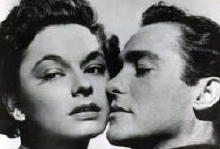
It might be Ruth Roman’s picture — and I’ll get back to that in a minute — and for the role she plays, she certainly makes the best of it. I think this is the earliest movie I’ve seen her in. I remember her most from her later days in television, where she gradually found herself playing much more mature roles. (She may be best known for her role as Sylvia Lean on Knots Landing, circa 1986.)
Here she appears slim and vibrant and not quite so sure of herself, and for each of these reasons, but particularly the latter, she’s largely sympathetic as a woman who finds herself in a situation that moves continuously (and elusively) beyond her control.
But the most fascinating character in the movie is Liza McStringer. Mercedes McCambridge was by far not the most glamorous movie star in the world, and in fact until the 1970s, she did not do many movies at all, concentrating first as a radio star, then in TV, but never in a continuing series. (She was the voice of the demon in The Exorcist, and she had to sue in order to get the screen credit she was to have been given.)
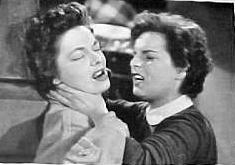
But if nothing, Mercedes McCambridge is one of the most intense actresses (she’s the one on the right) I can think of now, and that is what she is in this movie, absolutely intense. I think if I were on a jury, and she were of the other opinion, I can only imagine how easily persuaded I might be.
The romance in this movie is there only to hang a pretty good murder plot on, which come to think of it, isn’t really all that strong, either. I think that there’s a mutual symbiosis between the two, each making the other half of the story stronger, helping disguise a weakness at the center of the tale in the best possible way it might have been done.
July 11th, 2008 at 8:01 am
Hi Steve,
A footling footnote to Mercedes McCambridge on the small screen.
She was a regular in the 1956-57 ABC series Wire Service as one of three roving crime/adventure reporters, with episodes featuring her character rotating with co-stars Dane Clark and George Brent.
Some episodes had stories and/or teleplays supplied by such interesting names as AI Bezzerides, The Gordons, Fredric Brown, Daniel Mainwaring [Geoffrey Homes] and screenwriter Malvin Wald.
I’m afraid I can’t offer any personal observations as this remains an unseen series to me. Perhaps one day…
Regards,
Tise
July 11th, 2008 at 11:23 am
Tise:
Even though we had no ABC affiliate near us in upstate Michigan where I grew up, I have a strong recollection of seeing this series around then, probably on a syndicated basis.
I do remember watching a series in which Dane Clark was one of the stars, and from the dates, it pretty much has to be this one.
Was Mercedes McCambridge in it? My memory fails.
That’s an impressive list of authors they used as story sources, that’s for sure, but whether or not any episodes exist now, that’s a good question. A quick inquiry to one or two people who should know has come up with nothing — so far.
But they’ve promised to do some looking, so who knows. As you say, perhaps some day?
Best
Steve
July 11th, 2008 at 7:03 pm
LIGHTNING STRIKES TWICE is one of my favorite movies. It is directed by the great King Vidor. You can see links in atmosphere and setting to another, non-mystery Vidor film set in the Southwest, “Duel in the Sun” (lots of horse buggies and haciendas).
No one ever seems to watch LIGHTNING STRIKES TWICE. Even Vidor specialists in film discussion web-groups seem to have missed it. It is really obscure.
The atmosphere and storytelling are wonderful throughout.
July 11th, 2008 at 10:36 pm
The more I think about this movie, the more I’m sure I’ll have to watch it again.
I enjoyed it well enough the first time, but it usually takes a second time to see everything a movie has to offer.
— Steve
July 12th, 2008 at 2:19 am
Steve,
I don’t know why I enjoy this movie so much. But some of the scenes (the first night in the house, the account by the priest), just seem so interesting.
I agree with you that Mercedes McCambridge is remarkable. She was a superb villain in the Western “Johnny Guitar” (not a mystery).
My other favorite King Vidor film is the silent comedy “Show People”, about an actress breaking into Hollywood. His World War I film “The Big Parade”, his Elmer Rice drama “Street Scene” and the architect story “The Fountainhead” also have a lot of power.
November 9th, 2008 at 9:10 pm
[…] twice. Of all the titles of all the movies in the world, this is the second under this title to be reviewed on this blog. The second was filmed in 1951, a noir movie with Ruth Roman and Richard Todd. There is absolutely […]
June 28th, 2009 at 7:17 pm
I saw this film as a kid of about 10 years old on a UHF channel out of Youngstown, Ohio in black & white, late at night (probably around 1969). It has stuck with me all these years, especially for Mercedes’ performance. Truly, one of the greatest “crazy lady” performances of all time. Too bad it has been lost & forgotten. The atmosphere of this film, alone, is worth viewing. I wonder if there are any prints left of this, & if so, TCM or someone should pull it out of the vault.
June 28th, 2009 at 7:34 pm
Prints have to exist, since the copy I watched is one that I taped off one of the cable movie channels within the last ten years or so. I don’t know if it was TCM or not, but it was commercial free.
[…]
I’ve just found a “collectors only” copy for sale. It’s at http://www.samspadefilms.com/. It always pays to look there first, when Amazon, say, doesn’t have copies.
June 28th, 2009 at 7:46 pm
Steve, thanks so much for the info. I’ve not heard of this sight, & will definitely look into it. As you said, Amazon, etc., has no copies, even TCM, last time I checked, doesn’t have it in their library. Perhaps, this site may have other gems from the past that are forgotten. Thanks, again.
September 5th, 2009 at 10:24 pm
Lightning Strikes Twice is now available on DVD (r) from Warner Archives. I have not seen this, but 10 of the 12 examples of the Warner Archive movies I have seen were of excellent techinical quality, and the other two were fair.
September 25th, 2009 at 8:50 pm
Loved this movie as a young teen. Miss McCambridge was superb. Would love to see it again.
September 26th, 2009 at 4:21 pm
I just watched the Warner Archive DVD of this movie, and totally agree about Mercedes McCambridge. The kitchen scene in which Liza gives Shelly the whole backstory while making coffee and then ends it by rolling a cigarette with one hand and lighting it just blew me away.
October 1st, 2009 at 1:30 pm
Where can I buy this movie on DVD?
October 1st, 2009 at 2:13 pm
Here’s the link to Warner Archives:
http://www.wbshop.com/Lightning-Strikes-Twice-+EST-MOD/1000116371,default,pd.html?cgid=MOVIENEW
December 22nd, 2011 at 10:40 am
I am watching Lightning Strikes Twice on TCM at this very moment (12/22/11)!!
Thank you TCM for showing this….
& it is nice to know that there still folks out there who remain interested in these
old classics……….
December 24th, 2011 at 1:59 am
Looks like it was filmed in the High Desert in LA County & Angeles Forest Hwy
May 3rd, 2013 at 12:56 am
I trully enjoyed this movie, had not seen it in awhile. Ruth Roman and Richard Todd make a beautiful couple to watch. I loved the outdoor shoots, looks like it was filmed in the desert. also, I love King Vidor at a director.